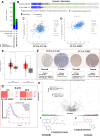Primary Hepatoid Adenocarcinoma of the Lung: A Systematic Literature Review
- PMID: 35676912
- PMCID: PMC9167841
- DOI: 10.2147/OTT.S364465
Primary Hepatoid Adenocarcinoma of the Lung: A Systematic Literature Review
Abstract
Background: Hepatoid adenocarcinoma (HAC) of the lung (HAL) is a rare and aggressive extrahepatic adenocarcinoma with an unknown etiology and unfavorable prognosis, which is similar to the pathophysiological characteristics of hepatocellular carcinoma (HCC).
Methods: We first presented a 67-year-old patient diagnosed with HAC in the right middle lobe of the lung. Then, a systematic literature search was performed for HAL cases recorded between 1990 and 2020 based on three databases. The clinicopathological features, therapeutic method, and prognosis of this rare disease were reviewed, and corresponding prognostic factors were explored using Kaplan-Meier (K-M) curve and Cox proportional hazards regression model. Additionally, the potential biological mechanisms of HAL were further explored and compared with HCC and lung adenocarcinoma (LUAD) based on online databases.
Results: In the present study, we reported an HAL patient who underwent surgical resection combined with chemotherapy and succumbed to disease 13 months after surgery. Additionally, a total of 43 experimental studies with 49 HAL patients, including the present case, met the inclusion criteria and were included in the present review. We found that HAL is characterized by a male-dominated incidence and is more common in the right lung. Patients in the surgical subgroup have a better prognosis than those in the non-surgical subgroup (p = 0.034). Moreover, the Cox proportional hazards regression model demonstrated that surgical resection can significantly improve the prognosis of HAL patients (p = 0.016). HAL is a rare disease associated with gene mutations that has a distinctive cause and unique pathogenesis. Additionally, Afatinib and Gefitinib may be new effective agents to better combat HAL.
Conclusion: In conclusion, males may exhibit an increased risk of developing HAL and poorer prognosis than females. Surgical resection combined with chemotherapy may prolong the survival of patients with HAL. HAL has its unique clinicopathological characteristics and biological mechanisms.
Keywords: HAL; biological mechanisms; hepatoid adenocarcinoma; prognosis; review.
© 2022 Chen et al.
Conflict of interest statement
The authors declare that they have no competing interests.
Figures









Comment in
-
Hepatoid Adenocarcinoma of the Lung: Beyond a Shadow of Doubt and Risk of High Mortality [Letter].Onco Targets Ther. 2022 Aug 2;15:837-838. doi: 10.2147/OTT.S380304. eCollection 2022. Onco Targets Ther. 2022. PMID: 35942190 Free PMC article. No abstract available.
References
Publication types
LinkOut - more resources
Full Text Sources
Miscellaneous

